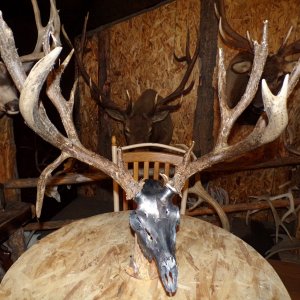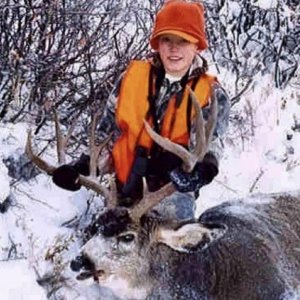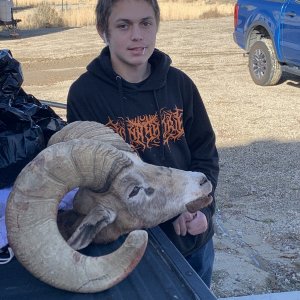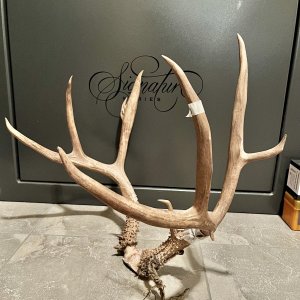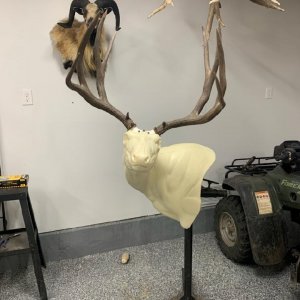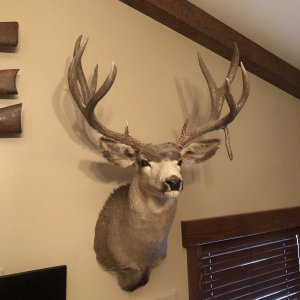B
bluelk
Guest
The Muzzleloading 102 Chapters are going to be devoted to the evaluation and testing of products. If any manufacturer of a muzzleloading rifle/pistol, accessory, or product wishes to have their product tested and the results published here on the forum they are free to provide it for evaluation. This is where "the rubber meets the road".
As I posted earlier, I have just completed a comprehensive evaluation of the Austin & Halleck .50 caliber inline rifle. Here are the results and my comments:
RIFLE NOMENCLATURE: Austin & Halleck, .50 caliber, Model 320SS, stainless steel barrel (octagon to round), bolt action, black sythetic stock, 26" barrel, .003 depth rifling, 8 lands and grooves, 1:28 twist, solid aluminum ramrod with brass tip, fiber optic sights, Weaver scope mounts. Came equipped with a 209 ignition that is convertible to #11 percussion caps and musket caps. Included with the rifle were the different nipples, scope rings, a package of Harvester copper clad bullets and sabots, a short starter, and the breech plug disassembly tool.
GENERAL OBSERVATIONS: Very nice fit and finish. The depth of the molded in checkering on the stock made for a good gripping surface, which is better than that available on most synthetic stocks. Had a Monte Carlo style cheek piece which made centering of the eye on the sights very positive. The "fleur de lis" design was attractive.
The ramrod seats firmly and positively. Better than some on the market. No need for a ramrod lock such as is necessary with some rifles. Very substantial ramrod ferrule. The ramrod is marked with a bold red line to indicate when a powder charge of 100 grains and a conical bullet are inserted in the barrel. Obviously this mark will indicate if any sizeable powder charge and bullet are in the barrel. A really nice feature.
Trigger guard is molded into the stock and is large enough to accomodate gloves. Nice feature.
"Pull" measured 13" when measured from the front of the trigger to the mid-point of the butt. This is about an inch shorter than the "pull" on most inline muzzleloaders. Initially it appeared as a problem because I am 6 ft. and weight 230 lbs., but it rapidly became a non-issue through repeated usage. This became apparent during the ballistics testing.
There is one safety, which is very positive and adequate, but some shooters may like the double safety offered on some inlines. Obviously, this is a matter of personal preference.
The short starter has a recess molded into it that allows you to push down on the ramrod if you encounter resistance while loading a bullet. Nice feature.
Minor damage to the crown of the muzzle, but was easily corrected with a light sanding of crocus cloth.
BALLISTICS TESTING:
As all of you know I lap the barrels on all rifles and this was no exception, even though I DID NOT observe any cotton fibers adhering to the bore. Ran the lapping compound for 50 repetitions, and applied the Teflon treatment. Used the KG-6 Moly Bore Prep and was very pleased with it. Used Birchwood Casey Choke Tube Lube on the breech plug, and Bore Butter on the barrel. Cleaned the bore, bolt, and breechplug with the new Remington Vortex and was very impressed with it's cleaning ability. Simple, fast, and REUSABLE! Installed a Bushnell Banner 3x9 scope and bore sighted for 100 yards, and used my chronograph.
Ballistics testing took place on the 21st and 22nd at the Phoenix Gun Club because the Ben Avery range was conducting the NMLRA winter shoot.
Over the 2 days I fired a total of 200 rounds of 348-grain hollow point lead BlackBelt bullets and used Goex Clear Shot 2f and 3f powders.
It took 8 shots to center the strike of the bullet on the bullseye. Fired in 9 shot strings because of the lack of fouling build-up from the Goex Clear Shot.
Consistently got 2 and 3" groups at 100 yards without the use of my Bench Master bench rest. When I used the bench rest I got 1-1/2" groups. Velocities with the 2f Goex Clear Shot averaged 2027 fps, and with the 3f it averaged 2213 fps. Very, very respectable numbers with tht weight bullet. Why these vbelocities? The 209 shotgun primer! I started with a powder charge of 100 grains of 2f and worked up to 150 grains with constantly improving velocities until 130 grains. The velocities tended to level off at that point with no appreciable increases. Started with a powder charge of 100 grains of 3f and worked up to 130 grains with constantly improving velocities throughout the range. The velocities did not level off. Due to the increased breech pressures of the 3f I decided to not go any further while testing for accuracy. The Optimum Hunting Load for the 348 grain bullet with 2f powder was at 130 grains. With the 3f powder the Optimum Hunting Load was at 120 grains.
I did not use the #11 percussion cap nor the musket caps. My reasoning was that if the average shooter had the 209 primer available why would he use anything less, so I didn't bother. By the way, I used the Winchester 209 shotgun primers.
After finishing the ballistics testing I loaded powder charges that were much higher than 130 grains of 3f and had no negative effects other than a sore shoulder!
OBSERVATIONS: A very nice, comfortable, well-made, accurate rifle. Would I class it as a "tack driver?" YES. Would I recommend it as a rifle for someone to purchase? YES. Is it on a par, or superior, to other inlines on the market? You bet! Because the barrel is longer than the average inline it does become a little barrel heavy, but I also believe that the longer barrel contributes to the overall accuracy of the rifle, but I don't believe that a reduction of the barrel length to 23-24" would seriously degrade the accuracy. I had absolutely no problem with the breechplug or Choke Tube Lube. Blowback from the 209 is greater than from a #11 or musket cap, and was as I expected. It was properly directed to the pressure relief port.
BEST FEATURE: An absolutely smooth, positive, sensitive trigger. Vastly superior to many muzzleloading rifles.
Austin & Halleck website: www.austinhalleck.com
As I posted earlier, I have just completed a comprehensive evaluation of the Austin & Halleck .50 caliber inline rifle. Here are the results and my comments:
RIFLE NOMENCLATURE: Austin & Halleck, .50 caliber, Model 320SS, stainless steel barrel (octagon to round), bolt action, black sythetic stock, 26" barrel, .003 depth rifling, 8 lands and grooves, 1:28 twist, solid aluminum ramrod with brass tip, fiber optic sights, Weaver scope mounts. Came equipped with a 209 ignition that is convertible to #11 percussion caps and musket caps. Included with the rifle were the different nipples, scope rings, a package of Harvester copper clad bullets and sabots, a short starter, and the breech plug disassembly tool.
GENERAL OBSERVATIONS: Very nice fit and finish. The depth of the molded in checkering on the stock made for a good gripping surface, which is better than that available on most synthetic stocks. Had a Monte Carlo style cheek piece which made centering of the eye on the sights very positive. The "fleur de lis" design was attractive.
The ramrod seats firmly and positively. Better than some on the market. No need for a ramrod lock such as is necessary with some rifles. Very substantial ramrod ferrule. The ramrod is marked with a bold red line to indicate when a powder charge of 100 grains and a conical bullet are inserted in the barrel. Obviously this mark will indicate if any sizeable powder charge and bullet are in the barrel. A really nice feature.
Trigger guard is molded into the stock and is large enough to accomodate gloves. Nice feature.
"Pull" measured 13" when measured from the front of the trigger to the mid-point of the butt. This is about an inch shorter than the "pull" on most inline muzzleloaders. Initially it appeared as a problem because I am 6 ft. and weight 230 lbs., but it rapidly became a non-issue through repeated usage. This became apparent during the ballistics testing.
There is one safety, which is very positive and adequate, but some shooters may like the double safety offered on some inlines. Obviously, this is a matter of personal preference.
The short starter has a recess molded into it that allows you to push down on the ramrod if you encounter resistance while loading a bullet. Nice feature.
Minor damage to the crown of the muzzle, but was easily corrected with a light sanding of crocus cloth.
BALLISTICS TESTING:
As all of you know I lap the barrels on all rifles and this was no exception, even though I DID NOT observe any cotton fibers adhering to the bore. Ran the lapping compound for 50 repetitions, and applied the Teflon treatment. Used the KG-6 Moly Bore Prep and was very pleased with it. Used Birchwood Casey Choke Tube Lube on the breech plug, and Bore Butter on the barrel. Cleaned the bore, bolt, and breechplug with the new Remington Vortex and was very impressed with it's cleaning ability. Simple, fast, and REUSABLE! Installed a Bushnell Banner 3x9 scope and bore sighted for 100 yards, and used my chronograph.
Ballistics testing took place on the 21st and 22nd at the Phoenix Gun Club because the Ben Avery range was conducting the NMLRA winter shoot.
Over the 2 days I fired a total of 200 rounds of 348-grain hollow point lead BlackBelt bullets and used Goex Clear Shot 2f and 3f powders.
It took 8 shots to center the strike of the bullet on the bullseye. Fired in 9 shot strings because of the lack of fouling build-up from the Goex Clear Shot.
Consistently got 2 and 3" groups at 100 yards without the use of my Bench Master bench rest. When I used the bench rest I got 1-1/2" groups. Velocities with the 2f Goex Clear Shot averaged 2027 fps, and with the 3f it averaged 2213 fps. Very, very respectable numbers with tht weight bullet. Why these vbelocities? The 209 shotgun primer! I started with a powder charge of 100 grains of 2f and worked up to 150 grains with constantly improving velocities until 130 grains. The velocities tended to level off at that point with no appreciable increases. Started with a powder charge of 100 grains of 3f and worked up to 130 grains with constantly improving velocities throughout the range. The velocities did not level off. Due to the increased breech pressures of the 3f I decided to not go any further while testing for accuracy. The Optimum Hunting Load for the 348 grain bullet with 2f powder was at 130 grains. With the 3f powder the Optimum Hunting Load was at 120 grains.
I did not use the #11 percussion cap nor the musket caps. My reasoning was that if the average shooter had the 209 primer available why would he use anything less, so I didn't bother. By the way, I used the Winchester 209 shotgun primers.
After finishing the ballistics testing I loaded powder charges that were much higher than 130 grains of 3f and had no negative effects other than a sore shoulder!
OBSERVATIONS: A very nice, comfortable, well-made, accurate rifle. Would I class it as a "tack driver?" YES. Would I recommend it as a rifle for someone to purchase? YES. Is it on a par, or superior, to other inlines on the market? You bet! Because the barrel is longer than the average inline it does become a little barrel heavy, but I also believe that the longer barrel contributes to the overall accuracy of the rifle, but I don't believe that a reduction of the barrel length to 23-24" would seriously degrade the accuracy. I had absolutely no problem with the breechplug or Choke Tube Lube. Blowback from the 209 is greater than from a #11 or musket cap, and was as I expected. It was properly directed to the pressure relief port.
BEST FEATURE: An absolutely smooth, positive, sensitive trigger. Vastly superior to many muzzleloading rifles.
Austin & Halleck website: www.austinhalleck.com

